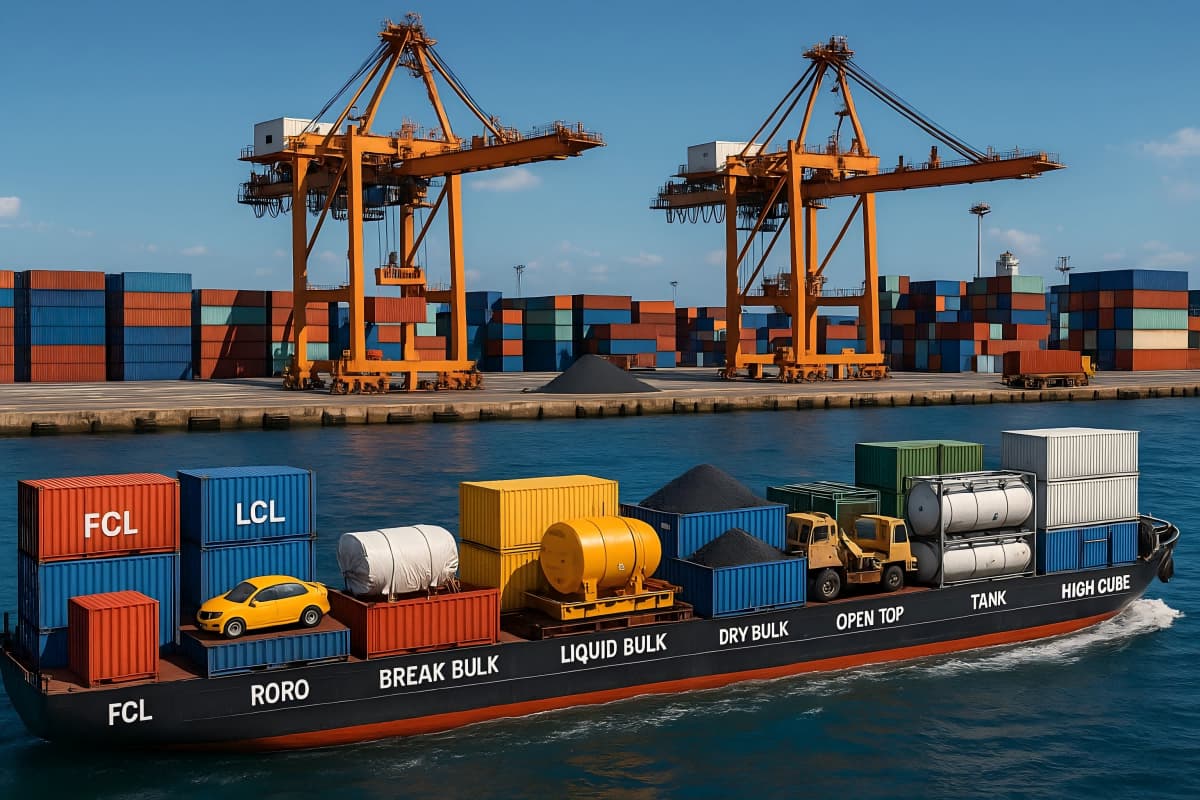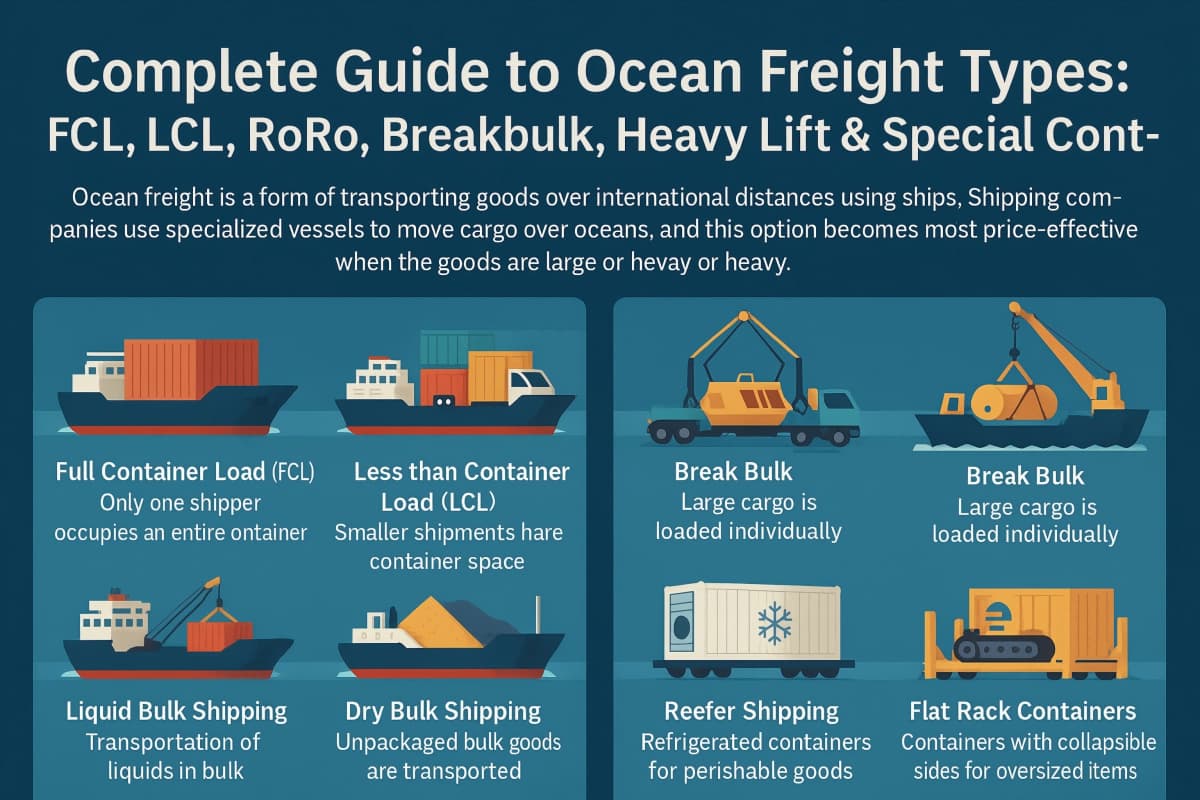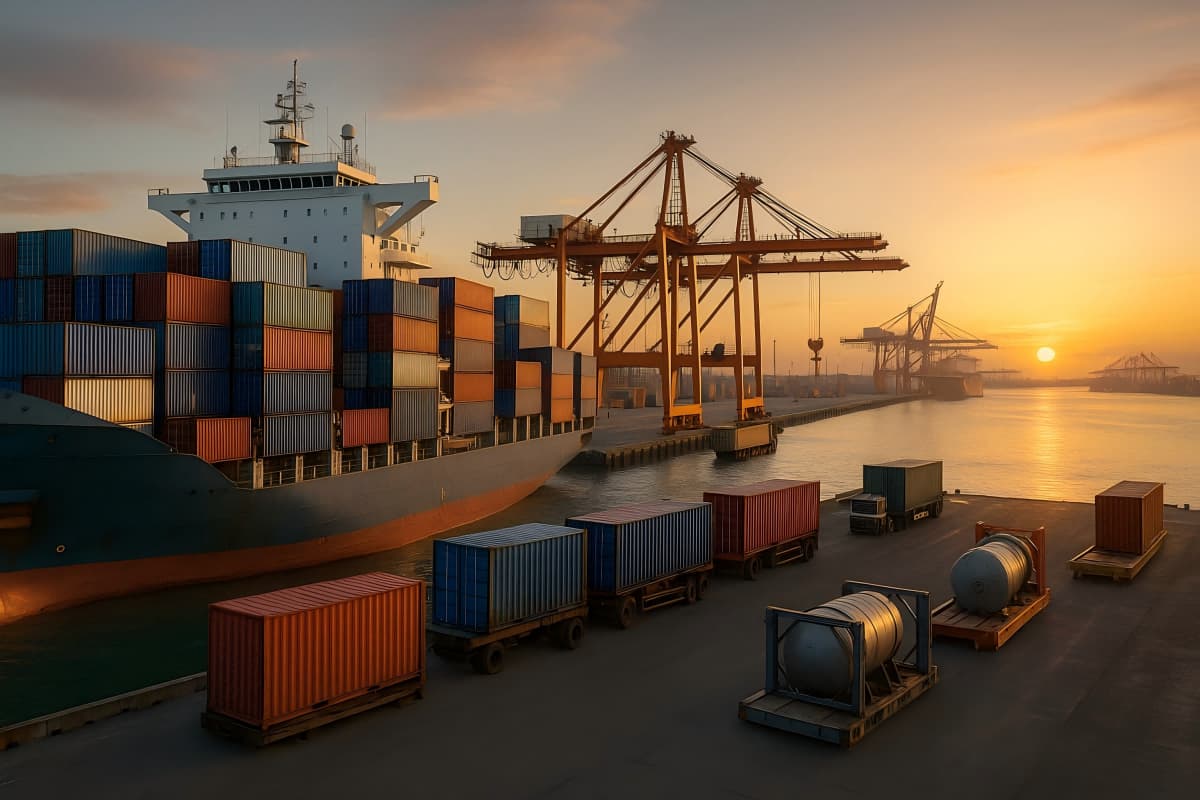Complete Guide to Ocean Freight Types: FCL, LCL, RoRo, Breakbulk, Heavy Lift & Special Containers

Ocean freight is a form of transporting goods over international distances using ships. Shipping companies use specialized vessels to move cargo over oceans, and this option becomes most price-effective when the goods are large or heavy.
For ocean freight shipping to succeed, operators must take several vital steps to ensure the safe and efficient movement of goods. At the beginning, the packaged goods are organized and loaded on board a cargo ship. The ship subsequently journeys to the chosen port, after which the cargo is taken off. Then, customs approval is sought, and the goods travel to where they are meant to be delivered.
For ocean freight, shipping containers, which have set sizes of 20 feet and 40 feet, are used to move goods. Containers designed for specific products, particularly liquid and dangerous goods, improve safety and make the transportation process more efficient. In addition, modern logistics now leverage advanced solutions such as 3d container loading to maximize space efficiency and minimize shipment damage.

Types of ocean freight services
Different kinds of international ocean freight export services are available for overseas trading. This guide will focus on 11 of them. These services are used for shipping everything, whether big or perishable. Every type brings its own set of benefits.
Full Container Load (FCL)
FCL allows only one shipper to use an entire container. It functions well for shipments involving furniture, heavy industrial machines, or items in bulk. Goods are loaded into a secure container at the beginning point and stay undisturbed until they reach their destination. This approach enhances safety and cuts down the possibility of seeing transport damage because things are moved less. FCL operates at a quicker pace since there are fewer stops and transfers.
For example, our dedicated Global FCL Service ensures that your full container load is handled exclusively for your shipment.
Less than Container Load (LCL)
LCL consolidates different smaller shipments from several businesses in one container, which is more affordable for frequent shippers. Although LCL is an economical choice because several shipments travel in one container, the repeated handling of packing and unpacking goods raises the risk of damage. So, a strong packaging will help ensure goods condition.
By utilizing our freight lcl service, enjoy cost-effective solutions without needing to fill an entire container.
Roll-On/Roll-Off (Ro-Ro)
Lorries and vehicles are loaded onto Ro-Ro ships and transported by riding on the ship. This system is very efficient for moving cars, trucks, buses, and heavy equipment. Cars are loaded onto the boat at the beginning port using regular driving methods and moved off at the end stop in the same way. Moving cars with Ro-Ro shipping is an easy and economical approach to preventing vehicle damage.
Our process leverages roro ocean carriers to streamline the loading and unloading of vehicles.
Liquid Bulk Shipping
The service is used to move liquids in bulk, including oil, chemicals, and liquefied natural gas. These items are generally transported on oil and chemical tankers, which are built to store and move hazardous or safe-to-handle liquids. When you choose liquid bulk shipping, you ensure that large amounts of liquid are handled safely and efficiently.
Dry Bulk Shipping
Grains, coal, minerals, and ores are bulk goods that dry bulk ships move without packaging. Their large holds allow for the transportation of loose bulk items. Shipping in this way can be the best option for handling large volumes of one type of material. Using machines such as conveyors, cranes, or scoops for loading and unloading makes this process practical for bulk products.
Our dedicated solution for Bulk cargo ensures that even loose and un-packaged materials are transported with optimal care and efficiency.
Reefer Shipping
Reefer containers hold and transport food, pharmaceutical drugs, and flowers because they allow safe refrigeration. Shipping reefer containers control the temperature during the trip to keep goods fresh. Goods that depend on consistent temperatures travel best with reefer shipments. These containers can regulate temperatures from below freezing to room temperature, making them versatile for various perishable items.
Flat Rack Containers
If cargo is too large for a standard container, you can use a flat rack container. These vehicles are collapsible on the sides and ends and are perfect for carrying large machinery, pipes, and vehicles. Using a flat rack, it is easy to handle shipping from the side or top. They can also be used to carry items that are wide and heavy.
Open Top Containers
These containers are designed so that the top can be removed, permitting cargo to be loaded from above. Heavy and tall things like timber, scrap metal, and machinery are commonly placed in these containers. You should use open-top containers for cargo that needs to be placed from the top because it's too large for the container door. Over-height cargo is easily moved thanks to containerized roof decking.
Tank Containers
Tank containers are built for transporting liquids and gases. They are designed to meet worldwide rules for safe trains. Chemicals, wine, and edible oils are. Tankers ensure the safe and easy transportation of all kinds of liquids.
High Cube Containers
High cube containers are specifically made to carry large, wide items that won't fit into standard containers. These machines usually have a height of 9.5 feet, while regular ones are 8.5 feet tall. For lightweight and big items such as furniture, cotton, and plastic products, high cube containers are preferred. The extra level gives more space to store things without making the container bigger where it stands.
How are ocean freight rates calculated?
Many different factors can impact the costs of ocean freight. Factors we consider include the amount being shipped, its weight, and the distance covered from one port to another. These costs assist you in making shipping plans and budgets.
- Shipment Volume and Weight: How much you ship and how much it weighs play a significant role in determining costs. Bigger or heavier shipments can become more expensive. Rates are often determined based on cubic meters or tons.
- Distance and Route: The shipping price depends on how far apart the two ports are. A longer route often leads to higher fuel bills and a greater time commitment. The path you take plays a role, because popular routes may lead to lower costs.
- Container Type and Size: The cost of containers depends on their type and size. Vessels use both 20-foot and 40-foot containers as the main types. However, refrigerated and tank containers are more costly because they are different from regular containers.
- Freight Class and Cargo Type: The cargo's classification by nature plays a role in setting the price. Packing items that are easy to break may cost more and take more time. Sometimes, the cost of insuring valuable items is higher.
- Market Demand and Seasonality: Shipping prices vary based on current demand and season. When many people travel during holidays, prices tend to go up. However, off-peak seasons may offer less expensive rates.
- Fuel Costs and Surcharges: The increasing price of fuel affects shipping costs. Carriers may charge extra for fuel, and rising fuel prices around the world may impact surcharges.
- Currency Exchange Rates: Fluctuations in currency exchange rates can influence costs. When shipping internationally, changes in currency values affect the overall price.
- Service Level and Additional Services: The required level of service can affect costs. Basic services are cheaper, while additional services like packaging, warehousing, and expedited shipping increase costs.
- Carrier Contracts and Negotiations: Rates can vary based on contracts and negotiations between shippers and carriers. Long-term contracts might offer better rates than one-time shipments.
- Port Fees and Handling Charges: Ports charge fees for handling and processing shipments. These fees include loading, unloading, and storage charges. They vary by port and can significantly impact overall costs.
- Insurance: Insurance coverage for the shipment is an additional cost. It protects against damage, loss, or theft during transit. The premium depends on the value and nature of the goods.

When to choose ocean freight
Ocean freight is advantageous for certain logistics requirements, especially when moving large, heavy, or bulky items across great distances. It tends to be more affordable than air freight, making it an appealing choice for budget-sensitive shipments. If timely delivery isn't crucial, the extended transit times of ocean freight can be a suitable option. This mode of transportation is also better suited for carrying hazardous materials and oversized cargo that might be prohibited on aircraft. Moreover, for companies aiming to reduce their environmental impact, ocean freight presents a more sustainable option with a significantly lower carbon footprint.
Choose Ocean Freight:
- Large, Heavy, or Bulky Goods: Best for shipments that are large or heavy.
- Cost-Effectiveness: More affordable for budget-conscious shipments.
- Non-Urgent Deliveries: Suitable for goods that do not require fast delivery.
- Hazardous Materials: Allows for the transport of hazardous and oversized items.
- Environmental Concerns: Offers a more sustainable shipping option with lower carbon emissions.
In conclusion
With ongoing advancements in emerging technologies in ocean freight operations, such as ocean freight tracking, logistics, and route optimization, and a growing emphasis on the ecological impact of ocean freight, the sector is continually evolving.
Companies are increasingly focused on optimizing ocean freight routes, enhancing port operations, and improving customer service, which ensures the resilience and sustainability of ocean freight services.
Ocean freight companies' commitment to adapting to changing market demands, regulatory environments, and customer needs keeps the wheels of global trade turning, making ocean freight a critical component of the world economy.
Partner with CargoesPi for all your ocean freight needs across North America, Europe, and beyond. Contact CargoesPi now.

